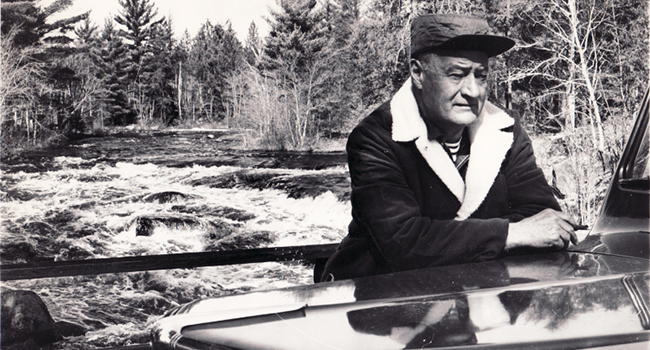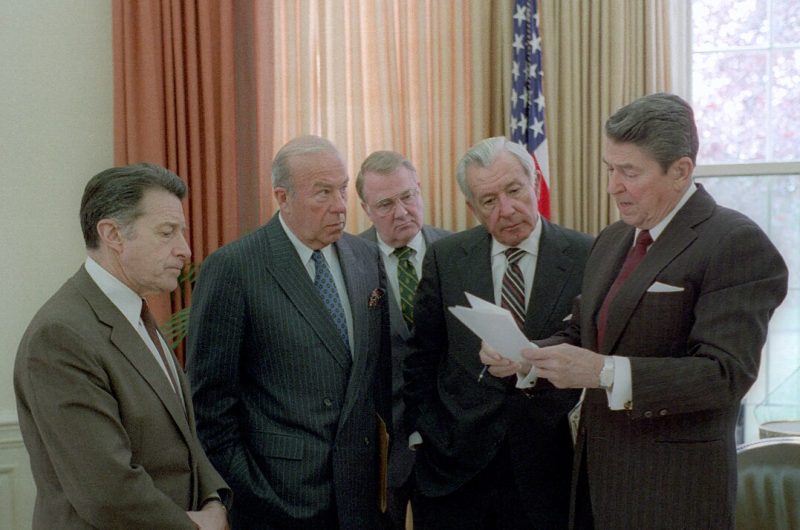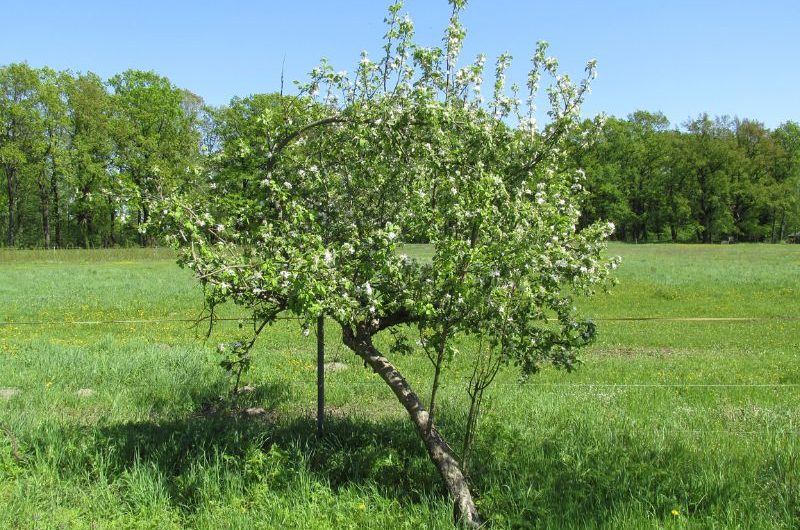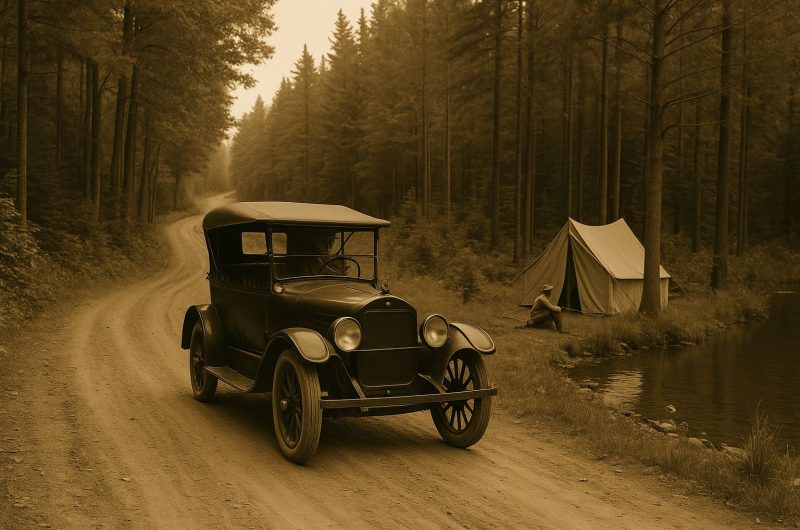John D. Voelker, Food, and Drink

John Voelker aka Robert Traver was the best-known author of the twentieth-century Upper Peninsula. His best novel is Anatomy of a Murder but he also wrote many short stories and novels. Here I would like to delve into Voelker and how he presented food and drink in his works and conclude with a look at John Voelker’s legendary food habits.
In the afterword in Laughing Whitefish, Voelker wrote:
A writer best learns his craft by writing, I suppose, and from this book, I learned that dressing up fiction in a bustle doesn’t make it any easier to write. Harder, if anything, because there is additionally the constant problem of authentic idiom, dress, furnishings and all the rest. And constantly one must be on guard against the illusion-shattering anachronism.1
Voelker’s connection with food and drink went back to his grandfather, Nicholas who settled in Ontonagon in 1845 and operated a brewery and his father, George who owned a saloon in Ishpeming. In this context Voelker came into contact with food and beverage at an early age.
In three of his works, Danny and the Boys, Trouble Shooter: The Story of A Northwoods Prosecutor, Laughing Whitefish we see evidences of Voelker’s focus on food and drink. In Trouble Shooter Voelker wrote about a county prosecutor, a position which he held himself. True to form he wrote that “I have a profound temperamental distaste for all formal public utterance, florid or otherwise, I usually manage to duck these affairs and go fishing.” But he continued,
Then there are the weddings, the picnics, and the celebrations to which I am constantly being invited. If I can be assured that I won’t have to climb up on a beer keg and howl and bray for the crowd, I usually am not only willing but anxious to join my
people in their recreation. As you may be beginning dimly to suspect, I have an unabashed appetite for undisciplined play ….”2
There were various celebrations that Voelker wrote about. He “would not miss the local Italians’ Columbus Day ‘celebrash’ for all the tea in China.” Later he attended the wedding of Aune and Jooseppi Maki held in Henry Harju’s house in Hematite. Here we are given a slice of food and drink served at the reception. “Perspiring Lempi, Henry Harju’s housekeeper, ladled out steaming drafts of boiling coffee. Large cakes and platters of cookies heaped the kitchen table.” After this appetizer and Finnish fortunetelling, the wedding party “left for Kaleva Hall for the wedding supper and dance” which though not described must have been more substantial than the sweet treats and coffee.3
At deer camp there were descriptions of the use of beer and whiskey. Such discussions are to be found in many short pieces throughout Voelker’s writings. At one point Dan, one of the characters, was introduced to canned beer much to his surprise. Later Dan would sum up drinking at deer camp:
He [Dan] got up an danced a goatish jig. “Ne wrinkle hell! Beer in a can. Beer in a can. Dan, Dan, the thirsty ol’ man, drunk oceans of beer out an ol’ tin can. Dan grabbed a bottle of whisky and ran into the other room. I followed, smiling ruefully at brother Leo, for it looked like a stormy night on the shores of Silver Lake.
“Hey, you goddam Traver boys,” Dan shouted. “An’ you, Yack Seem, you bloody round-headed Swede. We got to celebrate. First night in camp. Your ol’ man always celebrated first night in camp. Here, Leo, open this goddam newfangled bottle! It’s teasin’ me to death. I always said give me a cork.”
As the drinking continued Traver realized that he needed some food. Dan responded by heating up the iron kettle filled with “old mulligan stew.” This seems to have been a staple food item as it is discussed in Danny and the Boys as well. After several more drinks and camp talk they proceeded to have dinner,
We sat down and ate, like famished animals, each spearing out the steaming food from the black kettle: beaver, onions, salt pork, salt bear, potatoes, venison, carrots, partridge, muskrat — Dan triumphantly labeled the catch as each one brought up a new curiosity.4
In Danny and the Boys there are numerous accounts related to food, Upper Peninsula style. When Danny McGinnis was a youth he was a chore boy or “bull cook” for the lumber camp cook. He denied that they were ever forced to partake in horseflesh. As Dan told it,
What really happened was me an’ the cook run clean out a mushrooms! Would you believe it—them bloody high-toned lumberjacks went into a pout an’ wouldn’t eat their porterhouse steaks nor nothin’ ‘thout they was smothered in mushrooms. It’s as true as I’m settin’ here!5
In another place he briefly writes about the Sunday pasty dinner — “the proverbial Cornish meat and Suet pie.”
Danny also told tales of moonshining. His still was “beside the little creek in the dense cedar swamp, just beyond the birch ridge.” After some trouble with the fire, Danny “sampled his last batch of moonshine generously”, ran off a last batch and hid the “warm gallon jugs of fresh moonshine under his favorite stump.”6
There are also descriptions of saloons both outside and inside. Voelker continued with his description of the interior of the saloon which he attributed to being owned by one Charlie Jokinen, a Finnish immigrant who “possessed a constitutional allergy to all hard work, including iron-mining.” As a result he was now the sole proprietor of Charlie’s Place.
There were fourteen saloons on the town’s Main Street and many more on the side streets. On Saturday nights and on paydays all of them were busy, for then hundreds of miners surged downtown, cashing their vouchers from the iron mines, paying bills, mingling with the lumberjacks and farmers, buying new boots and socks and heavy miners’ underwear and, most of them to the dismay of the local temperance workers, “sneakin’ a few dollars on the ol’ woman for a bloody drink or two!7
Now moving into the interior, Voelker continues his description of a typical early twentieth century Upper Peninsula saloon:
Charlie’s worn mahogany bar ran nearly half the depth of the long, high room. At the far end of the bar . . . stood the free-lunch counter, covered with cheesecloth against the droning flies. On the wall was a neatly printed sign: “Free lunch——25¢.” The counter was flanked by a massive icebox. Beyond that was the partitioned, green-tabled poker tables, At the back of the saloon was a small kitchen and the “Sunday door,” leading out to the alley in the rear. Over the entire establishment there hovered a delicious, stale, boozy smell——a subtle combination of stale beer, mustard, cold ham, old cheese, brine of pickled herring, spilt whisky, over-loaded spittoons, sweating men.8
At one point Dan went to “the new Cliff Dwellers Inn” or in reality the Mather Inn9 in downtown Ishpeming. This red-brick colonial hotel——conceived by an architect from Boston, transplanted elms and all—looked rather incongruous in the afterglow on a glacial side hill of the mining town of Chippewa [Ishpeming]. It was the favorite haunt of the mining officials and their wives.
Entering the bar he [Dan] was momentarily bemused by the colorful Welsh and Old English hunting and drinking scenes which adorned the walls. The resourceful Boston architect was not going to let any indigenous scenes of logging and iron-mining corrupt his faery brain child.
Dan quickly “discovered the glittering new un-Welishian neon and chromium bar.” In this fancy setting, Dan who was wearing “aromatic red plaid hunting jumper and his ‘high water’ stag pants and muddy rubber boots” “loudly ordered a double shot of pile run whisky.” Then “there was a pause in the bar’s occupation, known as the drinking hour” as he repeated his order. When the bartender asked him which mix he preferred, Dan stared at him and the bartender sunk “to the argot of the proletariat” and asked him what he wanted for a wash. Dan answered, “gin!” “whereupon the cocktail stragglers giggled and roared and carelessly flung down their dry Martinis.”10
Eventually Dan met his party of four Chicago fishermen and took them to Hungry Hollow. Although properly attired and equipped for fly fishing, the four Chicagoans caught nothing but a few small fish that they returned. They were seeking large rainbow trout. Meantime Dan was catching his fill including a Grandpaw rainbow. When it was over Dan invited the visiting fishermen for a meal of trout which they accepted. The next morning the fishermen awoke to “throbbing of pulse and coated of tongue, blindly groping for the water pail.” However Dan had “them relaxed and smiling with a round of Highland Flings.” The ingredients for this hangover buster was simplicity itself: a “tripler” of Hungry Hollow moonshine, a dash of lemon juice, a little sugar, and some boiling water. Dan was careful to stress, “Never too much water.” While he was explaining this drink he was “expertly flipping over a batch of buckwheat cakes on the smoky griddle.”11
The distillation of moonshine was a common practice in the Upper Peninsula both before and after Prohibition. Voelker refers to it with Dan was a leading moonshiner. References are made throughout his writings, but there is a chapter, “The Raid” which goes into splendid detail into Dan’s moonshining or making “cooking whisky.” For Thanksgiving dinner, Danny and the boys had venison, rabbit and partridge.
In Laughing Whitefish there are a number of references to drink. The festive Christmas drink Tom & Jerry is mentioned, “I went to my tiny pantry and prepared myself an elaborate Christmas drink: rum, milk, eggs, grated nutmeg, more rum—lots of rum.” A little later Voelker writes, “Tom & Jerrys not only furnish food and drink, but, with the slightest application to their consumption, a free night’s lodging as well.” In the trial Native Americans use the term “swam in the milk” referring to a drunkard. Typical of many of the characters in Voelker’s stories and novels, one of them orders “double bar whiskey an’ a snit of beer.” In the same instance another character orders a mere cherry soda.12 Following his original concern with authenticity, Voelker stayed with the food and beverage of the time that he was writing.
Not all of Voelker’s accounts of food come from his novels and short stories, but appear in his personal accounts of fishing. Voelker enjoyed mushroom hunting and in Trout Madness wrote about cruising the woods for the “Oyster Mushroom.” In his “mushroomy meditations” he noted “after years of research I’ve discovered that mushrooms, unlike trout, can only be ‘caught’ if they’re there, while with trout, alas even when they are there, one’s troubles only often begin.” Mushroom hunting was important to him as he pointed out he carried in his “bush car” two illustrated books on wild mushrooms. On other occasions he wrote about exploring the woods with friends and pausing to pick whatever wild berries or cherries or mushrooms might be out,” and then he continues “sometimes winding down dining at some obscure rural café on such neglected ‘gourmet’ delights as genuine Cornish pasties or Italian polenta—rarely found anymore in even the fanciest franchised restaurants.”13
While out in the woods on fishing trips in his “bush car”, Voelker a variety of “necessary” items from fishing equipment, to auto repair material to food and drink. As he wrote in Anatomy of a Fisherman in 1964, “Since fishermen occasionally must eat, naturally my jeep is an ambulant supermarket bulging with jars and bottles and assorted canned goods . . . and enough wine, beer and miscellaneous booze to get half the county plastered.” It should be added that he had all of the kitchen and dining equipment from a Primus stove to folding tables and chairs. In Trout Madness that he observed he usually had “grub for a week, mostly bottled and canned” and Buckshot his “fish car” “always” carried “a supply of beer and a bottle or two of whiskey—always when I leave that is.”
Voelker occasionally consumed the trout he caught and provides us with some insights to serving the trout. His observations and instructions to preserving, cooking and serving trout follow:
Trout were never designed to be embalmed along with the steaks and ox joint of the aristocracy of the new Ice Age in their well-larded deep freezers. Trout should be eaten not later than twenty-four hours after they were caught, else one might better eat damp swamp hay crowned with chain-store mayonnaise. But by far the best time to enjoy your trout is beside the waters where they are caught. Take a fry pan along and some bacon or shortening, and a little cornmeal and salt, and have yourself a feast fit for a king—or an ulcerated millionaire.14
If John Voelker included mention of food in his literary works he “was as passionate about food, as he was about fly fishing and music, and his wife” [Grace]. At home and camp he liked simple foods which had flavor and taste. “He loved his wife’s cooking, and she was an excellent cook.” He especially loved chipped beef on toast. However as Ted Bogdan noted: “It is a lost art. I don’t think anybody makes it anymore.” Another of his favorite home foods was creamed cod fish. Grace would buy the salted box cod, soak it for a long period of time and then cook it. She would make a cream sauce which was served over the cod which sat on a bed of mashed potatoes. Voelker was also fond of the pasties, which Grace made.
At fishing camp the food varied. Bogdan would prepared food in town and finish it at camp. His stews flavored with wine and mushrooms were popular. Voelker was extremely fond of Italian food. His friend Gigs Gagliardi would bring a variety of Italian food. They also grilled steaks and chicken breasts on a regular basis.
Voelker had an interest in mushrooms and hunting for them. His personal library had numerous books related to the science and collecting of mushrooms. His good friend Ted Bogdan was a mushroom expert having grown up in Illinois on a family mushroom farm. The two of them, sometimes joined by the county extension authority on mushrooms, Ingrid Bartelli and Dr. Alexander Smith, an authority on mushrooms from the University of Michigan would hunt for mushrooms and then retire to camp to enjoy the product of the hunt. The mushroom hunting season began in the middle or latter part of May and started with hunting for black morels, followed by white morels. Peppery flavored oyster mushrooms were next, followed by early chanterelles, Italian porcini which brought them to September and the end of the season.
The opening day of trout season in the spring was the time for a grand celebration. It was playfully referred to as St. Salvelinus Fontinalis Day—a “holy day of obligation” devoted to fishing. It was a time of the gathering of people who had come into Voelker’s life—locals, sports writers, family, friends. There were the foods brought by guests or grilled on the spot and this was one of two times during the year when trout were served. At this time and throughout the season, grilled were a treat for everyone and a favorite of Voelker. Bogdan’s recipe for grilled mushroom:
Pull the stems of the mushrooms and grill not too close to the heat. Soften them. There was juice in the mushroom that gathered inside first. Wait until it cools of, drink the juice first, then eat the mushroom. True essence of the flavor is the mushroom.
When Charles Kuralt, the CBS reporter who visited Voelker, tried the mushrooms, he declared them one of his three best foods that he had ever eaten.
Voelker’s drink of choice was the whisky old fashion and only the old fashion. He considered other drinks—martinis and manhattans—”fancy” drinks to be avoided. According to Bogdan:
John made the best old fashions. Not just according to me and my friends, but according to anybody who ever had one. He would start by pouring a little water in a old fashion glass. He would macerate one cube of sugar. Then he would pour in the booze, which was Cabin Still, Evan Williams, and later Jim Beam. The times remember best was when we had Cabin Still. Later
on they changed the formula and it wasn’t the same. Then it was two shots of bourbon and then he would squeeze an orange in
there. We also used maraschino cherries and a couple drops of Angostura] bitters. It’s hard to believe, but two people can make
them side by side and they’ll taste different. He would make them individually and the first drink was extremely strong. As the
time passed and you drank your drink, it was replenished with water and bourbon. You would just keep nursing the original drink.
Voelker drove around in what he termed his “fish car” or his own car while his wife had the “second car.” In the fish car he carried everything that he might need. Prominent on the back seat was “the cooler with ice cubes and a little basket. The tin cups, sugar cubes and the bitter were there along with a bottle of fresh water.” One time when Voelker and Bogdan traveled to New Orleans, the cooler came with them and they enjoyed old fashions on the banks of the Gulf of Mexico against a beautiful sunset.
The “exotic foods” cannot be forgotten and were primarily seafood. On the trip to Louisiana the two of them enjoyed crawfish though they were served by a basket-full to them. Voelker also loved a variety of oysters: raw, Rockefeller, Casino. When Bogdan owned and operated the Crow’s Nest at the top of the Heritage House (now the Landmark Inn) Voelker had a fine source of seafood. In all cases the food had to be tasty.
Just to veer off from the straight story of food and drink. In a sense Voelker was indirectly involved with traditional medicine and could have been involved in a minor farming project. It seems that in the late 1950s or early 1960, the Jack Daniel distillery folks gave John some land, probably a lot in Lynchburg. Over the years during the 1960s, the Moore County agricultural agent encouraged him to grow tobacco or sell the land. At one point the Frank Bobo family wrote John and asked his permission to gather stalks of pokeweed. Its roots are poisonous and the young shoots are sometimes used as potherbs. The Bobo boys gathered the plants and used them as a remedy for Frank’s bilious condition! That was the extent of Voelker’s involvement with traditional medicine or tobacco farming.
In later life, Voelker continued to enjoy these foods and drinks. To his diet was added Russo’s roasted chicken. Although Voelker enjoyed good food, he never cooked any of it and relied on his wife and friends to supply him with culinary delights.
1Robert Traver. Laughing Whitefish. New York: McGraw-Hill Book Company, 1965, p. 311.
2Robert Traver. Trouble-Shooter: The Story of A Northwoods Prosecutor. New York; Viking Press, 1943, p. 209.
3Traver. Trouble-Shooter, pp. 210 and 213.
4Traver. Trouble-Shooter, pp. 285-288.
5Robert Traver. Danny and the Boys: Being Some Legends of Hungry Hollow. Cleveland and New York: The World Publishing Company, 1951; reprint, Detroit: Wayne State University Press, 1987, p. 12
6Traver. Danny, p. 42.
7Traver. Danny, p. 52.
8Traver. Danny, pp. 53-54.
9At this writing The Mather Inn is still standing in downtown Ishpeming but it has been closed for many years while the owner works on its renovation as an apartment building.
10Traver. Danny, p. 104-105.
11Traver. Danny, pp. 113-114.
12Traver. Laughing Whitefish, pp. 167, 122, 169, 237.
13Traver Robert. Traver on Fishing. Edited by Nick Lyons. Guildford, CT: The Globe Pequot Press, 2001, pp. 293, 284.
14Traver. Traver on Fishing, p. 88.
15Ted Bogdan Interview, Marquette, Michigan, June 3, 2003, deposited at the Central Upper Peninsula and University Archives, Northern Michigan University. This interview is the only substantial work which deals with John Voelker’s food and beverage likes. It forms the basis for this latter part of the chapter.






Thank you for this. My grandfather, August “Chocolate” Olivanti was a friend of Judge Voelker. I remember him telling stories of going on fishing and hunting trips with “Johnny” as he called him. My grandma Julia made him plenty of Italian food, including polenta. My grandparents lived in Iron Mountain.
Booze seems to have had a more central, even glamorous, role in the stories of that era. It’s a wonder Judge Voelker found time to write, hunt , fish and even serve as a Michigan Supreme Court Justice .
Russ,
I have read most of Voelker’s works and your essay brought back many pleasant memories. Thanks!
Mr. Voelker and my father, Miles Betts, worked together and sometimes fished together. I called him, “Mr. Traver,” and he liked that. One day, before they set out to go to camp, Mr. Traver stopped at the Red Owl Supermarket where I worked and asked me to help him find good lobster tails (frozen) for him to take on his fishing expedition. “This reveals a lack of confidence in your angling abilities,” I thought.
Wonderful read, Russ. Gentle Ted Bogdan became our friend in his later years. Thanks for the memories.
I was doing some work out at Iverson snowshoes and and John Voelker stopped in. I had just finished reading Laughing whitefish. I asked him a question about the book. It surprised me that he did not recall. I was young then and it makes more sense to me now. He asked me who my favorite character was and then turned to tell me that his favorite character was the alcoholic old lawyer
I was so pleased to have met him and he was so delightful
Thanks for this article, Well done
I have spent a fair share of time looking for information on Mr. Voelker, studying all I have found. I appreciate you lifting these details from his work. In a class I used to teach, students were asked to speak to the role(s) food played in a work. Was it about helping others, passing on traditions/culture, pride in craft? It is interesting to consider what place it took in Voelker’s work. The above details might simply full under the general heading of a literal appetite for joy. So much of what I read about Mr. Voelker suggests he sought that, perhaps to offset some of the losses he dealt with in his life, something few folks speak to in discussion of him.
I appreciate the article and the comments from folks who knew Mr. Voelker.